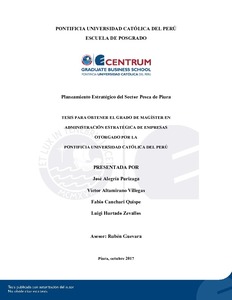| dc.contributor.advisor | Guevara, Rubén | |
| dc.contributor.author | Alegría Purizaga, José | es_ES |
| dc.contributor.author | Altamirano Villegas, Víctor | es_ES |
| dc.contributor.author | Canchari Quispe, Fabio | es_ES |
| dc.contributor.author | Hurtado Zevallos, Luigi | es_ES |
| dc.date.accessioned | 2017-11-08T20:46:45Z | |
| dc.date.available | 2017-11-08T20:46:45Z | |
| dc.date.created | 2017 | |
| dc.date.issued | 2017-11-08 | |
| dc.identifier.uri | http://hdl.handle.net/20.500.12404/9691 | |
| dc.description.abstract | El presente plan estratégico se ha realizado sobre la base del Modelo Secuencial del
Proceso estratégico elaborado por D’Alessio (2014), con el objetivo de que una organización
o sector económico pueda alcanzar la visión deseada (D’Alessio, 2016). Este Plan
Estratégico proporciona los lineamientos que guiarán las decisiones y acciones estratégicas
para convertir el sector de la pesca industrial en la región de Piura, en el tercer sector
productivo con mayor contribución al PBI de la región.
Para ello se debe aprovechar al máximo la riqueza del mar frente a la costa de Piura,
la ubicación geográfica de la región, y los tratados de libre comercio. Entre los hallazgos
encontrados en la formulación de este plan estratégico, las principales oportunidades son la
alta demanda tanto local como del exterior por los productos de buena calidad, y la ubicación
comercialmente estratégica. Las principales fortalezas son la abundancia y diversidad de
recursos hidrobiológicos, y las debilidades encontradas fueron la pesca ilegal y depredadora.
El logro de este plan estratégico está basado en el cumplimiento de las diez estrategias
propuestas: (a) incrementar la extracción y consumo de nuevas especies comerciales marinas;
(b) desarrollar productos nutricionales ricos en proteína animal; (c) penetrar en nuevos
mercados internacionales; (d) impulsar las implementaciones de certificaciones
internacionales; (e) trabajar conjuntamente con el Gobierno para incrementar el consumo
humano directo per cápita de la región; (f) establecer alianzas estratégicas con los operadores
logísticos para agilizar las exportaciones; (g) implementar tecnologías extranjeras; (h)
mejorar la infraestructura portuaria por parte del Estado; (i) incrementar el presupuesto en
I+D para el estudio de nuevas especies marítimas comerciales; (j) captar nuevas inversiones
para el desarrollo del sector. Los seis objetivos de largo plazo trazados están enfocados en
lograr el desarrollo económico deseado y sostenible dentro de un marco socialmente
responsable | es_ES |
| dc.description.abstract | This strategic plan is based on the Sequential Model of Strategic Process, which
includes a set of activities that take place sequentially in order for an organization or
economic sector to reach the vision established (D’Alessio, 2016). This strategic plan
provides some guidelines that will guide the decisions and strategic actions to convert the
industrial fishing sector in Piura region to become the third largest productive sector with the
highest contribution to GDP in the Piura region, offering several products with high quality
standards and generating profitability with leading technologies.
To this end, it is necessary to take advantage of the wealth of the sea off the coast of
Piura, the geographical location, and free trade agreements. Findings of this strategic plan
show the high level of informality in the region as one of the main factors affecting the
development of this sector, as well as the low technological level and low diversity of
products extracted, compared with other countries. This strategic plan proposes the
fulfillment of 10 strategies and 6 long-term objectives, which are focused on the achievement
of economic and sustainable development within a socially responsible framework.
To this end, we must take full advantage of the wealth of the sea off the coast of
Piura, the geographical location of the region, and free trade agreements. Among the
findings found in the formulation of this strategic plan we have as the main opportunities the
high demand both locally and abroad for good quality products, commercially strategic
location, traceability exchanges of marine products, and free trade agreements; The high level
of informality and corruption, the low level of technological development and research have
also been found as the main threats. As the main strengths we have the abundance and
diversity of hydrobiological resources, and the high nutritional content of these resources,
regarding the weaknesses were illegal and predatory fishing, boats without adequate
conditions to optimize the extraction and the cost of non-competitive production in relation to
other countries. The achievement of this strategic plan is based on the fulfillment of the 10
proposed strategies which are: (a) To increase extraction and consumption of new marine
commercial species; (b) developing nutritional products rich in animal protein; (c) To
penetrate new international markets; (d) to promote the implementation of international
certifications; (e) work together with the government to increase direct human consumption
per capita in the region; (f) establish strategic alliances with logistics operators to expedite
exports; (g) implement foreign technologies; (h) Improve port infrastructure by the state; (i)
increase the R & D budget for the study of new commercial maritime species; (j) capture new
investments for the development of the sector. And the 6 long-term objectives outlined are
focused on achieving the desired economic development, and sustainable within a socially
responsible framework | es_ES |
| dc.language.iso | spa | es_ES |
| dc.publisher | Pontificia Universidad Católica del Perú | es_ES |
| dc.rights | info:eu-repo/semantics/openAccess | es_ES |
| dc.rights.uri | http://creativecommons.org/licenses/by-nc-nd/2.5/pe/ | * |
| dc.subject | Industria Pesquera -- Perú -- Piura | es_ES |
| dc.subject | Planificación estratégica | es_ES |
| dc.title | Planeamiento estratégico del sector pesca de Piura | es_ES |
| dc.type | info:eu-repo/semantics/masterThesis | es_ES |
| thesis.degree.name | Maestro en Administración Estratégica de Empresas | es_ES |
| thesis.degree.level | Maestría | es_ES |
| thesis.degree.grantor | Pontificia Universidad Católica del Perú. CENTRUM | es_ES |
| thesis.degree.discipline | Administración Estratégica de Empresas | es_ES |
| renati.discipline | 413307 | es_ES |
| renati.level | https://purl.org/pe-repo/renati/level#maestro | es_ES |
| renati.type | https://purl.org/pe-repo/renati/type#tesis | es_ES |
| dc.publisher.country | PE | es_ES |
| dc.subject.ocde | https://purl.org/pe-repo/ocde/ford#5.02.04 | es_ES |






